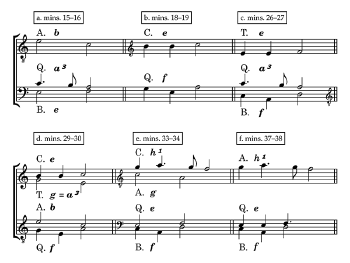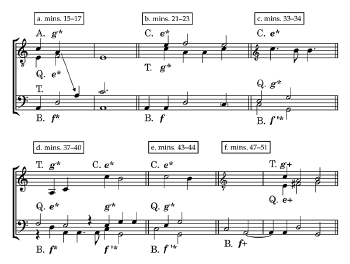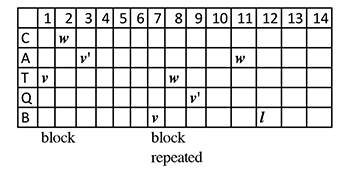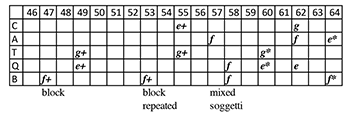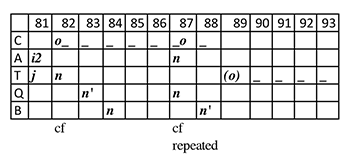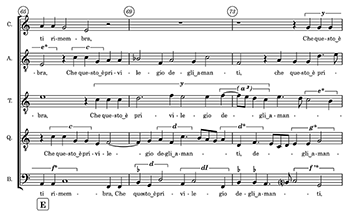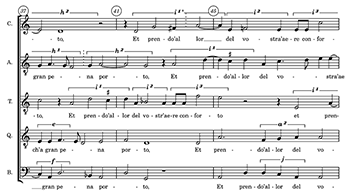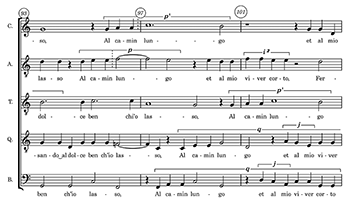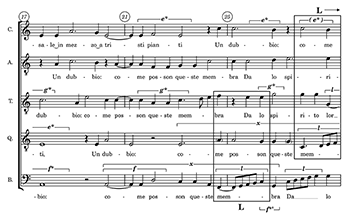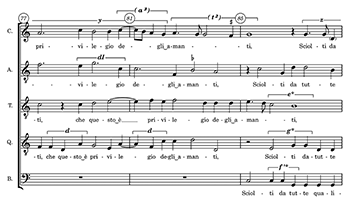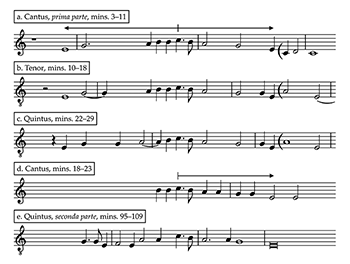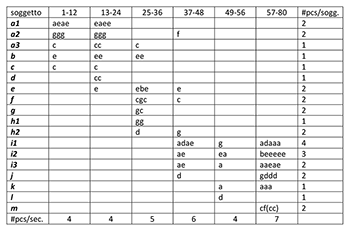Willaert’s Elusive Counterpoint Explained*
Peter Schubert
KEYWORDS: Analysis, Counterpoint, Form, Madrigal, Motivicity, Renaissance, Willaert, Zarlino
ABSTRACT: Willaert’s contrapuntal idiom in Musica Nova (1559) has been characterized as “elusive” because it “largely eschews imitative textures, clear cadential articulations, distinctive rhythmic patterns and tuneful melodic ideas (soggetti)” (Fromson 2001). The present study aims to elucidate Willaert’s contrapuntal techniques in a late madrigal, “Io mi rivolgo.” Here, Willaert distinguishes sections by applying a different contrapuntal technique to each. In the absence of cadences and changes of texture, these switches of technique neatly articulate the structural members (verses, quatrains, etc.) of Petrarch’s sonnet. The analysis of the madrigal is based on melodic repetition, and relies in part on breaking long melodies into tiny fragments, using Rifkin’s principle of “motivicity” (1998).
DOI: 10.30535/mto.28.4.7
Copyright © 2022 Society for Music Theory
I. Introduction
[1.1] It is easy to sympathize with Michèle Fromson’s characterization of Willaert’s Musica Nova madrigals:
From a modern perspective. . . the most notable feature of these late madrigals is their unusually dense and continuous contrapuntal idiom, which largely eschews imitative textures, clear cadential articulations, distinctive rhythmic patterns and tuneful melodic ideas (soggetti), which are no longer restricted to their conventional positions in the soprano and tenor parts but now roam freely and unpredictably among diverse vocal combinations. The result is an elusive contrapuntal idiom that has elicited a wide variety of critical responses from 20th-century performers and audiences alike, some of whom have found the madrigals unattractive and impenetrable even as others applaud their sensitive and expressive treatment of Petrarch’s elusive poetry (2001).
The problem faced by the analyst of Willaert’s madrigals is to find repeating patterns of melodic material. Next to Josquin’s methodical, crystalline soggetto repetitions,(1) Willaert’s melodies are so constantly varied as to appear capricious. How is it possible for the teacher of Zarlino, who described the soggetto so thoroughly (Rivera 1993), to have written such “impenetrable” music? One analytical approach would be to say that the soggetto—that is, the first long melody that sets a complete phrase of text—is “flexed” as to interval, rhythm, or both, when repeated in other voices. This approach is taken by John Milsom, who has dug deeply into flexed soggetti in discussing the music of Cipriano de Rore (2016). The problem is that there are no limits to flexing: any interval can apparently substitute for any other, and we are reduced to saying that it’s all just counterpoint!
[1.2] Another tack, the one I take here, is to see what, if anything, does repeat. In this I follow Joshua Rifkin’s principle of motivicity, which is based on finding melodic “units” that need not be articulated by rests or associated with words: to be structural, they need only be repeated.(2) Taking Rifkin at his word, I follow this principle wherever it leads. In the case of Willaert, it leads to finding tiny melodic units as short as two semiminims. (Rifkin does not specify any minimum length for his melodic units).(3) Because these units are structural, I will refer to them as soggetti.(4) What looks like constant, capricious variation—even when text, rhythm and contour resemble each other—is underpinned by the strict use of these short soggetti. I believe that Willaert knew, perhaps from his experience as an improviser, many other short melodies that would make useful combinations with them. What looks like random flexing of long melodies is explainable by other, more rigorous, means.
[1.3] In the sections that follow, I will first define five contrapuntal techniques: repeating blocks; contrapunto fugato (Schubert 2020); progressively linked motives; mixed motives (including canon); and quodlibet. Then I will show that a change of technique is used as a large-scale sectionalizing device in the relative absence of cadences and changes of texture.(5) These switches of contrapuntal technique align well with the structural members of the poem. The idea that a change of contrapuntal technique (other than the textural change from polyphony to homorhythm) can act as a marker of formal sections has not been explored much, save for Christopher Reynolds’ 1987 article on Josquin, in which he showed how canons at different intervals formed a palindrome.
[1.4] My test piece is “Io mi rivolgo” (RISM 1559 #13), chosen because it is representative of the style of madrigals in Musica Nova and because it has already received attention from two musicologists. (An annotated full score appears in Appendix 1, along with a midi audio file. The piece has been recorded by Singer Pur on Oehms Classics OC814.) Walter Gerstenberg wrote about this piece briefly in his foreword to the volume of Willaert’s Complete Works that contains this madrigal, where he assembled over a dozen samples of various kinds of repetition of “structural” voices (Gerstenberg 1966, v–vi). Martha Feldman, using an Arcadelt madrigal on the same text as a foil for defining Willaert’s style, also singled out a handful of musical features in it. I will try to untangle what she has called its “dense wash of polyphony,” which exhibits an “almost indefinable succession of textures, motives, and metrical stresses” (Feldman [1989] 2013, 208 [2013, 616]). Where Gerstenberg and Feldman chose a few excerpts as style markers, I will provide an analysis of the whole madrigal. The present article can be considered a companion to my 2021 MTO article on an earlier, much simpler, Willaert madrigal (“Amor mi fa morire”), in which very small melodic units are likewise used in structurally interesting ways. In addition to “Io” being much longer and in an entirely different style than “Amor,” it contains more different contrapuntal techniques and fewer cadences.
II. Labeling Soggetti
[2.1] The most important step in identifying contrapuntal techniques is the labeling of soggetti. Following Rifkin, I label any melodic fragments that repeat as meaningful units. Yet because they are so short and seem so “generic,” we must assure ourselves of their meaning by relying on context. To be labeled a soggetto, a melodic unit must be repeated as part of some identifiable structural procedure. A small melodic gesture such as a rising minor third, for instance, can be a soggetto if it is repeated in one of four contexts:
- When it is preceded and/or followed by another bit of melody that is repeated along with it.
- When it is consistently accompanied in the vertical dimension by the same bit of melody in counterpoint.
- When it is repeated in “interlock” with itself in imitation, sometimes in stretto fuga (Milsom 2005b).
- When it is repeatedly placed against a melody in mixed values that is used as a “figurated” cantus firmus (contrapunto fugato).
Some melodies that seem especially generic are the cantizans or the bassizans cadential motions; however, when these are treated according to any of the above principles, they too can be called soggetti. The only melodies that do not receive the status of soggetto are those that appear in the context of free counterpoint, where none of the other melodies around it are its comrades. Milsom has dubbed such melodies “singletons” (2005a, 303 and 325; 2016, 329).
Example 1. The opening of “Io,” prima parte, mins. 1–48
(click to enlarge and see the rest)
[2.2] Willaert’s soggetti are often altered as to durations, that is, “flexed” rhythmically, to use Milsom’s term (2016). For instance, in Example 1, soggetto a1 is an ascending minor third skip whose first note is a semibreve, but in mins. 21–22 it appears as a semiminim. (In all examples, I use minims instead of measure numbers for more precise location of soggetti; the minim numbers begin again at 1 in the seconda parte.) This diminished version of a1 is nonetheless considered a soggetto because it has both its subsequent linear comrade, a2, and two vertical partners, d and a2, as in mins. 13–14. Some soggetti begin in the middle of a sustained tone, for example soggetto d at min. 22, whose first note is the last semiminim part of the dotted minim C.
[2.3] Intervallic flexing happens occasionally, either between soggetti (as between soggetti a1 and a2 in Ex. 1, mins. 4–6) or between notes within a soggetto. This happens mostly when inganno is at work, as when the notes on either side of the alteration have the same semitone positions and hexachordal names. In the majority of those cases, the melodic intervals mostly retain not only diatonic size but interval quality as well (see [6.12]). These “splices” (Schubert 2021) or “hinges” (Milsom 2016) are marked by dotted lines in the example.
[2.4] Long soggetti must often be divided into their component parts. In Example 1, the long soggetto in the Cantus is divided into three shorter soggetti, a1, a2 and a3; this is because although a1 is sometimes joined to its linear comrades a2 and a3 (Cantus, min. 3; Quintus, min. 11; Quintus, min. 22), it also appears alone (e.g., Tenor, min. 13). This isolated occurrence of a1 can receive the label of soggetto because it is paired vertically with a2, as it was in mins. 11–12. Likewise in Example 1, mins. 24–26, soggetto a3 is labeled in the Bassus because it is followed by f, as it is in the Quintus immediately afterwards.
[2.5] Soggetti may be incomplete, lacking their first or last note. Soggetto a2 in its longest form consists of G-A-B-C but appears without its first note at mins. 4–5 and is missing its final C at mins. 11–12 (Ex. 1). I assign other labels to soggetti that are altered: “I” indicates a motive that has been inverted; a “prime” sign (’) indicates an intervallic alteration (melodic flexing, often due to inganno); a “+” sign means a note has been systematically added to the end of a soggetto in a combination that repeats; and an asterisk (*) indicates a soggetto that has been retrograded or that appears together with its retrograde.
[2.6] Some identical soggetti may be given different labels based on context. In Example 1, at mins. 28–31, soggetto g contains the descending minor third of a3 (without the fusa passing tone and its last note). It is appropriate to recognize this double meaning, because the two notes of a3 are combined with soggetto e as they were at mins. 26–27, making a vertical major third followed by a minor sixth. Yet at the same time, the three soggetti e/f/g in mins. 29–30, sounded together here for the first time, will be heard many more times; from now on, then, the minor-third skip will be labeled g to remind us of that origin. Other soggetti whose labels change due to context are e* (the retrograde of e, which is the same as the end of g and the same as i2), and j, which is the same as n. Some resemble each other a great deal when incomplete; for example, the incomplete g* is identical to a1. The results of the analysis would not be much changed by exchanging these labels, because we are interested in tracking little constellations of letters more than individual melodies.
[2.7] Sometimes different soggetti seem to contain each other, such as h1 and e in mins. 37–38 (Example 1). Soggetto e is defined as a rising semitone (usually in minims), while h1 consists of an upper neighbor and a stepwise descent. Because the F in e is extended to a dotted semiminim followed by a fusa E, however, it resembles the A-G-F motion of h1. This kind of echoing is a wonderful opportunistic detail made possible once the structural elements have been pieced together.
[2.8] If a soggetto appears with neither its vertical nor its melodic comrades, it is a singleton, considered part of free counterpoint and is not labeled. An example is E-C-F the Bassus in mins. 22–24 (Example 1). This has the diatonic shape of soggetto f; however, because it has no comrades, it is not a contributor to structure. Likewise in the Altus, mins. 23–24, the E-C is not soggetto b because of its isolation. Freely placed soggetti are labeled in two exceptional circumstances. The first occurs when recognizable soggetti are woven into longer melodies, like a3 embedded into soggetti y and z at the end of the madrigal. (Such interwoven fragments, when there is no other rationale for naming them, have been labeled in parentheses.) The second occurs in quodlibets (see [5.10–11]), when soggetti are recalled from earlier and sprinkled through the texture. (If the soggetti in quodlibets repeat with their comrades, they do not need parentheses). These are the only cases that are based on the judgment of the analyst and not on contrapuntal context.
[2.9] Several soggetti appear unaltered in only one voice, sometimes several times in a row. Motive b, for instance, appears four times in the first 30 minims in the Altus. It always appears as E4-C4; therefore, the line is fairly static; there is even a fifth occurrence at minim 24, but because it is not associated with any of its comrades, it is not labeled. A similar monotony can be heard in the Bassus, where two statements of d occur close together at the same pitch level (mins. 13 and 22), followed by two statements of f (mins. 26 and 33). Such melodic repetition is widespread in the madrigal. It may account for critical disappointment with Willaert as a melodist (McKinney 2009, 32–34), calling to mind Jesse Rodin’s well-known comments about “conspicuous” repetition in Josquin (2012, 43).
Varied Soggetti and Modules
[2.10] The second criterion listed in [2.1], that soggetti must be accompanied by one of their contrapuntal comrades in the vertical dimension, requires that we attend to modules. I have emphasized their structural importance elsewhere: “The module is more of a ‘made object’ than a single melodic line, and it is also more restrictive in determining the parts that are added to it. Such a complex structure is not likely to be repeated by accident!” (2007, 487). At the same time, Milsom has stressed the importance of different “interlocks,” which are combinations of thematic material in different temporal relationships that do not necessarily repeat (2000, 344). In “Io,” we find both modules and a variety of interlocks.
Example 2. Modules containing soggetto e in the prima parte
(click to enlarge)
[2.11] The next two examples show how soggetti e, f, and g are combined. It is worth spending some time with this combination, as it occurs so often in the piece. Example 2 tracks all the combinations that involve soggetto e at the opening of the madrigal (mm. 1–38). In Example 2a, soggetto e (a rising semitone) is heard against an incomplete a3 (a descending filled-in minor third) and b (a descending major third). In Example 2b, e is transposed up a fifth to B and sounded against f. In 2c, e and f are in the same relationship but transposed back down a fifth, and a3 returns. In Example 2d, e and f are back at the original pitch, as is b, and a3 appears as a part of g. In 2e, the combination e/f/g is down a fifth again, joined by h1. Finally, in 2f, the preceding combination is repeated without g.
[2.12] The appeal of the e/f/g combination is variety: it contains skips and steps, as well as contrary and similar motion. It also contains three pitch classes per chord, something valued by Zarlino (1558, 243), which frees the added voices from any obligation to complete the sonority. Both soggetti e and g contain the fifth of one of the chords, which explains why f is the one most often found in the lowest sounding voice.
Example 3. The first six varied e/f/g modules in the seconda parte
(click to enlarge)
[2.13] The seconda parte of the madrigal repeats the e/f/g module from the prima parte many times, but varies it by retrogradation, transposition, and the addition of a note, as shown in Example 3. In Example 3a, all three soggetti are marked with an asterisk, because they occur both in their recto and retrograded forms. (The recto form of soggetto f is missing its first note, C, and the retrograde form is missing its last note, C, so both forms contain only the two notes, D and A, which have their vertical comrades.) While we can read this as an A-minor chord, a D-minor chord, and an A-minor chord, these chords are also the products of thematic voice-leading motions that are heard in other contexts as well: e, for instance, has other comrades, a3 and b, at other times, as shown in Example 2a. In Example 3b, the upper voices are the same as in Example 3a, albeit inverted, but soggetto f occurs only in its recto form (the parenthesized C is a substitute note). Example 3c shows only the retrogrades of soggetti g* and e*, with soggetto g* transposed down a fourth and e* up a fifth (time shifted to make a suspension). Soggetto f′*, however, which normally would sound A-E against this pair as in Example 2d, has been transposed up a third.(6) This transposition changes the chord doubling and introduces a “major” sound with G-major and C-major chords. In Example 3d, e*/f*/g* is sounded in retrograde and then immediately with the “major” transposition as in Example 3c. This is an especially dense and beautiful succession, where e is transposed up a twelfth, g down a fourth, and f down only a step, giving the Bassus a little melodic sequence down by step. Example 3e is almost identical to 3c. In Example 3f, soggetto e rises a whole tone to approach the added note, G, while f is complete; all three soggetti have the added note that makes them e+/f+/g+, a new module that is repeated (see Example 5a).
[2.14] The ubiquity of these varied versions effectively casts the seconda parte as a developed version of the prima parte, particularly on account of the transposition to C-G of soggetto f’ and the alteration of soggetto e to e+ (E-
III. Repeating Blocks
Example 4a. “Io,” seconda parte, mins. 1–16
(click to enlarge and see the rest)
Example 4b. “Io,” schema of seconda parte, mins. 1–14
(click to enlarge)
[3.1] A block and a module are essentially the same, that is, they are contrapuntal combinations. However, whereas modules can be very short, rhythmically varied, and occur anywhere with respect to the text, blocks are longer and set the same words in the same rhythm. Gerstenberg (1966, vi) identifies some larger multi-voice structures in “Io.”(7) One of these is the upper-voice trio that is repeated in the lower voices, as shown in Example 4. Soggetto w is longer than the v and v′ soggetti and extends quite far to the right with one altered note, the A in parentheses. In Milsom’s parlance, this is a “ragged-edged” module, or “cell” (2016, 301n23). The recurrence of this block is intensified by appearing first in three voices, then again in five, with an extra w in the Altus.
[3.2] Gerstenberg’s characteristic sequence that occurs “independently” is the three-voice module labeled L in Example 4a. It consists of soggetto l, a stepwise rising fifth in the Bassus, set with upper voices that make root-position triads connected by stepwise motion. This module occurs once in the prima parte and three times in the seconda parte.
[3.3] Repeating blocks sometimes appear as if they might have been conceived as chord progressions, for instance the one on “Ma rispondemi Amor” (seconda parte, mins. 47–51), shown in Example 5. The Bassus and Tenor lines of this five-minim block are identical when it repeats in mins. 53–57, and the Quintus line is transposed up an octave in the Cantus. This looks like the kind of repeating block found in a madrigal by Maddalena Casulana, in which the bass stays the same and the upper voices exchange the same pitch classes to make 5/3 chords (Schubert 2018, 53–59). The Bassus here isn’t just any chordal bass, though: it’s a soggetto, f+. It sounds in combination with two shorter soggetti that are embedded inside the long block: the Tenor’s soggetto e+ and the Altus’s g+. Thus, even something that looks like a large-scale chord progression is made from the same little bits of thematic melody that have been circulating elsewhere in the madrigal.
Example 5a. “Io,” seconda parte, mins. 41–64 (click to enlarge and see the rest) | Example 5b. Schema of “Io,” seconda parte, mins. 46–64 (click to enlarge) |
Example 6a. “Io,” prima parte, mins. 81–92
(click to enlarge)
Example 6b. Schema of “Io,” prima parte, mins. 81–93
(click to enlarge)
[3.4] Following the repeating blocks, versions of soggetti e, f, and g start in min. 58. This moment marks the beginning of a “mixed soggetti” section (to be discussed in [5.5ff]). The rhythmic adjustment in the Bassus in mins. 58–60 allows soggetto f to accommodate the next text phrase, “non ti rimembra,” which is now presented as part of a stacked canon A/Q/B in mins. 57–60 (Gosman 1997).
IV. Contrapunto Fugato
[4.1] The technique of contrapunto fugato involves short motives being added to a long cantus firmus. It was routinely improvised by young singers (Schubert 2020) and occurs in an early madrigal of Willaert’s (Schubert 2021). In Example 6, short motives n and n′ are shown set against long soggetto o, a figurated cantus firmus (i.e., a line in mixed rhythmic values). The combination of the two ns in Tenor and Quintus against the long o is repeated a fourth lower beginning at min. 87, with o transferred from the Cantus into the Tenor and the two ns in the Quintus and Bassus. Soggetto n can be viewed as a fugue subject and n’ like its tonal answer, substituting a fourth with a fifth and a step with a third (splices are shown with dotted lines). The step down after the third note of n in the Tenor against the rising fifth of n′ in the Quintus (mins. 83–84) corresponds to the splice in n′, where a third down sounds against the rising fourth of n in the Bassus (mins. 84–85). These substitutions maintain the vertical intervals, an octave followed by a third, in the two combinations. This use of a splice in the “countersubject” is found frequently in Baroque fugues.(8)
Example 7a. “Io,” prima parte mins. 117–53
(click to enlarge and see the rest)
Example 7b. Schema of “Io,” prima parte, mins. 124–53
(click to enlarge and see the rest)
[4.2] In the next example of this technique, the long melody in the Altus (t in Example 7) is used twice as a figurated cantus firmus.(9) The first time it is almost exclusively accompanied by free counterpoint (mins. 124–33), and so is not a very convincing example of contrapunto fugato. Every melody is different, and no voice contains a recognizable motive, except for the first two notes of the tenor in min. 132—a false start of u, suggesting a stacked canon—and one d. The function of this free counterpoint is to set up the more contrapuntally intense repetition of t. The second time it appears (mins. 134–43), t is accompanied by a stretto fuga of melody u in the two lowest voices, and eventually by other motives, i2, i3′′ and d. Although soggetto t2 is a cadential cliché, it qualifies as a soggetto by its association with t1 and by its combination with d in mins. 141 and 149 (in uninverted double counterpoint at the fifth).
[4.3] Example 8 shows a more conventional contrapunto fugato with continually varied application of a single motive; this occurs beginning at min. 67. It starts after the end of the mixed soggetti shown in Example 5a. The imitation of soggetto c playfully anticipates the repeated Cs of long soggetto y, which appears twice, the second time a fifth higher. Against these statements, three versions of motive d are sounded a total of seven times. One of the ideals of contrapunto fugato is variety and, indeed, none of the ds creates the same combination of vertical intervals, since they occur in different temporal locations against y.
Example 8a. “Io,” seconda parte, mins. 65–88 (click to enlarge and see the rest) | Example 8b. Schema of seconda parte, mins. 65–85 (click to enlarge) |
V. Three Patterns of Short Soggetto Presentation
[5.1] Several sections of Willaert’s madrigal feature short soggetti not in blocks or in contrapunto fugato. These are disposed according to three principles: sometimes they are introduced in order as they advance through the text progressively; sometimes they appear randomly mixed up; and sometimes soggetti from earlier sections are reintroduced.
Progressively Linked Soggetti
Example 9. Schema of “Io,” prima parte, mins. 1–40 (cf. Example 1)
(click to enlarge)
[5.2] In the process of progressive linkage, new soggetti are introduced in overlap with old ones, and the old ones are discarded. This process is easier to grasp from a schematic reduction that takes all the labels from the score and displays them in cells on a timeline. Such a reduction of Example 1 is shown in Example 9. Here we can see that all the members of soggetto a disappear after min. 28. Soggetti b, c, and d are introduced successively against segments of a, and the last of these is discarded after minim 29. Soggetto e is introduced in min. 15 and f in 18. After min. 26, e, f, and g predominate. Two versions of soggetto h are added at min. 32 and transition to the next section with i1.
[5.3] Progressive linkage seems like a natural choice for a beginning a section of a madrigal, since new phrases of text are often accompanied by new melodic motives. Likewise, as the music progresses through the text, we may expect old text/music units to disappear. Willaert’s opening, however, is not as simple as that. The second poetic verse sneaks in at min. 27 with no dedicated soggetto; instead, it retains soggetti a3, b, e and f in the mix, so that verse 1 (“Io mi rivolgo
[5.4] Schematic reductions make it easier to see larger patterns within the point of imitation. The Bassus entry at min. 8 initiates a sequence of events that I will call a compound module, consisting of a3/b/a1, then c/a1 and a2, then a1/a2/d, followed by b/a3/e and finally by e/f. This sequence is repeated starting at min. 19 with some changes. The time between a1 and d in the Bassus is reduced, the solo a2 from min. 11 is eliminated before a1/a2/d (although another one is inserted after), and b/a3/e followed by e/f is conflated into e/a3/f. The result is that the second compound module is shorter than the first, 8 mins. vs. 11 mins. (The ends of e and f overlap the beginning of a1 in the Bassus and so are eliminated from the minim count.) This compression makes the second compound module more intense. Finally, three e/f combinations occur at regular intervals, specifically at mins. 29, 33, and 37.
Mixed Soggetti
Example 10a. “Io,” prima parte, mins. 37–80
(click to enlarge and see the rest)
Example 10b. Schema of “Io,” prima parte, mins. 41–80
(click to enlarge)
[5.5] Mixed soggetti account for four sections of “Io.” They differ from progressively linked sections in that old soggetti are not discarded, but continue to appear randomly mixed. The first of these sections, shown in Example 10, begins at min. 41 (i1 in the Tenor overlaps with the end of the preceding section). It contains almost none of the soggetti from the previous section. (Note that a2, in an unusual transposition, makes one appearance because it recurs with j in min. 34 of the seconda parte). The various parts of long soggetto i are heard all the way through but are varied and reassembled. First, the whole sequence i1(′)–i2–i3 is heard twice (Tenor, min. 38; Cantus, min. 41), then bits are broken off and sounded against each other and against j, k, l, and m. Beginning at min. 62, the three segments are reassembled into the sequence i2(′)–i3′′–i1, heard three times with new text: Altus, min. 62; Cantus, min. 66; Quintus, min. 70. These three soggetti are so generic—one is in fact a cantizans motion—that they can be presented in a wide variety of interlocks.
Example 11a. “Io,” prima parte, mins. 93–124 (mixed soggetti)
(click to enlarge and see the rest)
Example 11b. Schema of “Io,” prima parte, mins. 94–123
(click to enlarge)
[5.6] The section shown in Example 11 is joined to the previous section by an e*/f*/g* module (see Example 4a). I divide this section into three subsections. In the first, from mins. 93–105, soggetti p and p′ are in close imitation, likewise two statements of soggetto q, setting verse 6 (“Al camin lungo
[5.7] The sub-section beginning at min. 106, shown in Example 11a, is a typical example of Willaertian variation. Six of the seven melodies on the words “Fermo le piante” are related by text, rhythm, and melodic contour (up-unison-down-down), but only two have the same interval content (Bassus and Cantus); all the rest appear to be flexed in some mysterious way. Flexing is an attractive explanation, and this is how we might initially perceive these tunes; however, closer examination of the more fragmentary melodic motions and their combinations can lead to the recognition of hidden patterns that are strictly repeated.
[5.8] There are two pairs of patterns in this passage: Skips r and r′ (in a tonal, subject-answer relationship) are followed by either j or i3′. The combination of r′ against the last two notes of i3′ occurs twice, in mins. 110–11 and 112–13, the second time inverted at the twelfth. Similarly, the end of j in the Altus against r in the Bassus (mins. 106–7, vertical intervals 10-5) is like r in the Cantus against the descending third of i3′ in the Quintus (mins. 109–10, vertical intervals 5-10) inverted at the seventh. This slightly unusual interval of inversion represents a systematic operation that relates two combinations. To isolate this latter item (r/i3’) means disregarding the descending melodic third’s position in the melody, as well as the rhythm and text syllables. As compensation, instead of having to deal with six different melodies whose origins are at best mysterious, we need only reckon with two pairs of combinations of four shorter motives.
Example 12a. “Io,” seconda parte, mins. 17–52 (mixed soggetti)
(click to enlarge and see the rest)
Example 12b. Schema of seconda parte, mins. 15–45
(click to enlarge)
[5.9] Example 12 shows a section of mixed soggetti that sets verses 10–11. In the first subsection, long soggetto x appears in canon with itself. It contains l and the second and third notes of f, and it is counterpointed by soggetti e* and g* placed at different spots along the xs as well as by imitations of l. This section is quite complex because soggetti are welded together both in longer lines and vertically; at times, four soggetti are heard at once. The second subsection (mins. 33–44), setting verse 11, consists of a return to the varied e*/f*/g* modules (some embedded in a canon of q) that dominate throughout the seconda parte.
Quodlibet
[5.10] I call the third way of presenting mixed short soggetti “quodlibet,” a texture in which well-known tunes are assembled in a mishmash. Because they collect melodic material that has become familiar from earlier in the piece, quodlibets must occur near the end of a piece or section. In this case, soggetti can be presented outside of any contrapuntal context, and, obviously, the soggetti are no longer associated with the same text as at their first occurrences. The quodlibet from the end of the prima parte (Example 7a), contains soggetti d, f, i, l, o, s, and t. The final statement of i2 in that quodlibet contains an amusing inganno: instead of A-
Example 13a. “Io,” seconda parte, mins. 77–109
(click to enlarge and see the rest)
Example 13b. Schema of “Io,” seconda parte, mins. 86–109 (contrapunto fugato and quodlibet combined)
(click to enlarge)
[5.11] The finale of the seconda parte shown in Example 13 is more contrapuntally complicated than that in the prima parte, as it combines quodlibet with contrapunto fugato. The figurated cantus firmus is long soggetto z, which contains a3, e*, and g* within it. All the little soggetti sounded against z are from earlier in the piece, not only the pervasive forms of e, f, and g, but a1, a3, and two forms of soggetto d.
VI. The Poem and the Contrapuntal Techniques
Large-Scale Form
Example 14. The poem
(click to enlarge)
[6.1] By now the reader has seen all ten musical sections of the piece in the musical examples, albeit grouped by technique, not in the order in which they occur. A schema of the whole piece including the locations of poetic verses appears in Appendix 2, and a full translation is given in Appendix 3. Example 14 lines up the verses of the poem with the techniques and melodic content of each verse. The blue brackets show that these techniques are always paired within larger sections but are disposed—sometimes “nested”—irregularly. Changes of contrapuntal technique align very well with the structural verses of the sonnet by Petrarch and, in verse 12, with a caesura in mid-verse.
[6.2] The first verse is set in a straightforward manner with progressively linked soggetti. No change of technique occurs in the second verse, likely due to its enjambment with the first (and “Col corpo stancho” does not get its own soggetto) and so the same progression of soggetti continues. Willaert in this instance privileges syntax over versification, a preference Feldman has noted in his later madrigals (1995, 214 and 227).
[6.3] Verses 3 and 4 are distinguished both by a new technique and by the introduction of new thematic material. These similarly enjambed verses are joined in a single technique as well, mixed soggetti, with one particular soggetto (i) heard throughout. However, verse 4 is slightly marked off by the shuffled version of the parts of i: i2-i3’’-i1. The exclamation “oimè” is marked by the introduction of soggetto m into the ongoing texture and, as Feldman points out, by two other features: the “pregnant rests that sharpen the cries of ‘oimè lasso,’” and—referring to the unique syncopated-semiminim-fusa rhythm of the Tenor in min. 80, Example 10a—the “declamatory stringendo that increases the dramatic effect of the words” ([1989] 2013, [210], 618).
[6.4] The beginning of the second quatrain is marked by a switch to contrapunto fugato, with one voice declaiming “Poi ripensando al dolce ben ch'io lasso” in long values as a cantus firmus and the other voices declaiming the same text in canon in shorter values with a tonal answer (n and n′, mins. 81–93). The brevity of this section stands in contrast to the preceding long sections (see Appendix 2). Verses 6 and 7 switch back to mixed soggetti, and these two verses differ only by their melodic content: p and q for “Al camin lungo et al mio viver corto” versus r and s for “Fermo le piante sbigottito et smorto” (with i2 and j as constant elements (see [5.6–8]). Verse 8 employs the same technique as verse 5. Although the first three verses of this quatrain are enjambed, the music does not reflect that. It may be that the two middle verses are treated the same way because they rhyme (corto/smorto) to set them off from the outer two verses of the second quatrain that also rhyme (lasso/abasso). In verse 8 the contrapunto fugato is followed by a short quodlibet (see section 5.9) to mark the end of the octave and the prima parte.
[6.5] The seconda parte sets the beginning of the sestet with repeating blocks, a new technique. This is not particularly audible, since v, v′, and w all begin at different times with a repeated note and a neighbor motion (see Example 4). Even though the first and second verses of the sestet are enjambed, Willaert does not continue with the same technique as he did at the beginning of the piece. Instead, he sets off “Un dubbio” by introducing the e*/f*/g* module familiar from Example 3. The caesura after “Un dubbio” is not articulated musically in any way; however, Willaert does respect the following enjambment between the second and third lines of the tercet by continuing with the same technique.
[6.6] The beginning of the second tercet (verse 12) parallels that of the first one, with repeating blocks. These incorporate the e+/f+/g+ module (“Ma rispondemi Amor”; see Example 5). The caesura after this phrase (“But Love answers me”) is set off by a return to mixed soggetti, beginning with a stretto fuga of soggetto f (Altus, min. 57; Quintus, min. 58; Bassus, end of min. 58). The beginning of verse 13 is marked by a change to contrapunto fugato, even though verses 12 and 13 are enjambed. The beginning of the final verse continues with contrapunto fugato, made especially spectacular by the assorted soggetti from the prima parte (a3, d, e, f, and g) added to cantus firmus z.
Text Expression
[6.7] Feldman finds an aesthetic affinity between Willaert’s music and Petrarch’s poetry: “Through a continuous, unstable polyphonic web, it realized the meandering syntax Petrarch often utilized to embody his themes of spiritual uncertainty, evoking in musical abstractions effects parallel to Petrarch’s verbal ones” (Feldman 1995, 229). Regarding the approach of Venetian composers of the 1540s to word painting, she says: “In its emphasis on rhetorical shapes and syntactic processes, [this approach] avoided the dramatic and pictorial attempts to communicate semantic aspects of the text that are so famous in later madrigalian styles” ([1989] 2013, [206], 614).
[6.8] Nevertheless, Gerstenberg points out a few instances of word painting: the words lungo and corto in white notation (various long notes) and black (semiminims) respectively, and the generally low register for the word abasso (Gerstenberg 1966, v), especially in the Cantus (mins. 129–36). Most of the soggetti consist of, or contain, minor seconds, minor thirds, and/or minor sixths. This consistency of interval content recalls Timothy McKinney’s theory of interval affect in Willaert: it is probably in these pervasive intervals that the sadness of the text is expressed (McKinney 2009). Another example is the ostinato of i2/s (mentioned in section 5.6), which may portray the dismayed halting of steps in verse 7.
Example 15. Soggetti a (Exx. a–d) and z (e)
(click to enlarge)
[6.9] A striking instance of word painting is based on the phrase “io mi rivolgo” (“I turn back”). How would a musician respond to that, if not by retrograde. The e/f/g module often occurs with its own retrograde when it occurs as e*/f*/g*. And even more persuasive in this regard is the opening soggetto, a melody that contains its own retrograde! Other instances of the retrograde of this melody are the descending second half (Cantus, mins. 15-22) and soggetto z, with the same outline as soggetto a (looking backwards, as it were), shown in Example 15.
[6.10] At the same time that counterpoint remains the principal focus of this study, the examination of melodic fragments has important implications for modal analysis. To begin with, the melodies in Example 15 remind us of the example from Palestrina that Harold Powers adduced in his debate with Bernhard Meier over the third and fourth modes: “[T]here is every reason to take a melody that begins e-g-a-c’ as absolutely typical for mode 3. The difficulty here is that Palestrina obviously meant the motet Bonum est confitere Domino to represent mode 4” (Powers 1982, 67–69). Zarlino lists “Io” as an example of the third mode (1558, 324). Without getting into the debate, we can confidently say that “Io” is either third or fourth mode, an assessment that is confirmed by both the final note in the Tenor and the final sonority.
Example 16. Altus, mins. 78–85
(click to enlarge)
[6.11] Michèle Fromson would agree. She has noticed a great many liturgical melodies appearing in both motets and madrigals in Musica Nova, making the point that “In Willaert’s madrigals
Example 17. Beginning notes of soggetti, mins. 1–80
(click to enlarge)
[6.12] Finally, Willaert uses a very restricted palette of pitches for each of his short soggetti. A quick survey of the first 80 minims (i.e., the first two verses) shows that most begin on only one or two pitch classes; the average number of beginning pitch classes per soggetto is only 1.8—see Example 17. These occur mostly on notes that would have the same solmization names. Soggetto e, for instance, only occurs on E or B, both solmized as mi. That seems Phrygian enough, but what about all the soggetti that begin on notes solmized re or ut? It is worth considering that Willaert introduces “tonal” variety by emphasizing different solmization syllables at the beginnings of soggetti within each section; the average number of beginning soggetto pitch classes per section is five. Thus soggetti have consistent modal profiles, but sections are full of variety.
[6.13] This interpretation would help explain the diversity of goal notes of the many evaded cadences. The seven proper cadences are to G and E (three each), and one to A. The goals of the evaded cadences include D (at mins. 41, 46, 66, 121), A (at mins. 50, 62, 71, 75, 80), and C (in the seconda parte at mins. 27, 45, 77). These latter may indicate commixture. Carlos Cascarelli Iafelice has proposed something along these lines in analyzing a Willaert motet, concluding that it contains “a larger palette of nuances from the modal point of view [than a Morales motet]” and that “Willaert’s motet explores certain modal features that are not entirely compatible to the octonary tradition or even to versions of Aiguino’s system” (2021, 182; see also Harold Powers on “shifting tonal focus” 1989, 191–92). Comparing pitch locations of soggetti with cadence locations will add to our understanding of mode in Willaert’s music.
VII. Conclusion
[7.1] The foregoing account demonstrates the internal logic of “Io mi rivolgo” on the basis of the principle that musical structure depends on repetition. The method I have sketched out here may be replicated by analysts with enough patience to “look behind the tapestry, at the little knots” (as Patricia Carpenter used to say), and may eventually executed by computers.(10) In response to the reasonable objection that the soggetti I have identified are so short as to be merely generic, I would argue that Willaert’s music demands this treatment: he needs the little bits to be simple enough to be combined into longer, constantly varied melodies, and also to be placed against each other in acceptable contrapuntal combinations. As Feldman has noted, “Willaert created this kind of polyphony by manipulating the blandest of melodic materials” (1995, 229). She quotes an analogy by Bernardo Daniello, a literary theorist of Willaert’s time, on building up poems from the smallest particles (vowels, consonants, syllable lengths, accents):
And therefore, I would commend you, lads, were you not to disdain to imitate in your writings the master stonemasons who, before setting themselves to the task of building. . . choose those stones or tiles which seem to them most suited to the composition of the wall. . . . And then, having chosen them, begin to adapt and compose them with one another—now a large with a small, now a narrow with a wide; now a whole with a broken; sometimes one lengthwise, another one crosswise, placing one one way, another another way, until the wall reaches that height which it must in order to be beautiful and well proportioned.” (1995, 150)
I imagine, based on his use of contrapunto fugato, that “Adriano Cantore” was a great improviser as a young singer in Ferrara (Lockwood 2001), and that he could keep all these little fragments and combinations, like field stones, in his head.
[7.2] I imagine, for instance, that Willaert knew that soggetto i2, the semitonal neighbor motion in the prima parte (Fromson’s Savonarolan semitone, identical to e* in the seconda parte), could enjoy various interlocks with parts of a2, d, i1, j, k, l, p, r, s, and t2. The ability to hold many contrapuntal combinations in the mind is a skill that we have lost, making much Renaissance music harder for us to understand. To Willaert, these tiny melodies did not seem trivial and forgettable, as they do to us now.
[7.3] He might have begun by using each little soggetto as a melodic armature on which freer, more inventive music could be hung, using them to fashion the eleven-note melodies that accommodate the eleven-syllable verses of the poem. The madrigal abounds in ancillary melodies joined with thematic ones, such as the aforementioned Savonarolan tune (Example 16). One of my favorite joinings occurs in the Altus in the prima parte on “sbigottito e smorto” (Example 11a): the first three notes are ancillary and the last three are thematic, and an expressive cross-relation occurs on “smorto.”
[7.4] The next step for Willaert would be to use the long melodies to make combinations to repeat in blocks, or to treat as cantus firmi for contrapunto fugato sections. Even after deciding to distinguish poetic verses by melodic content (e.g., p and q vs. r and s), he would have had to decide which voices were to lead the way. I imagine that in the opening he decided early on that a1 in the Bassus would be followed by d sooner in the second compound module, and then he added the upper ancillary voices accordingly; or that he would shuffle i1, i2 and i3 the second time, or that he would compose something spectacular for the end (contrapunto fugato and quodlibet at the same time).
[7.5] Finally, we might wonder whether Willaert’s combinations of short melodic fragments are meant to be heard. The e/f/g combinations in Examples 2 and 3 are difficult to identify when heard in context, despite the frequency with which they repeat. I imagine Willaert saying to himself: “I can build a piece out of repeating combinations, as Josquin did, but present a much less obvious, predictable surface.(11) If I compose an imitative duo in one pair of voices, I won’t repeat it in another pair of voices.” Indeed, most of the long soggetti that imitate (f+, h1-h2, p, u or x), or that are used as cantus firmi (o, t1-t2, y, z) sound only twice (exceptions are a, that sounds a third time altered, and q and w, that sound again but are truncated). He might have added, “If I do repeat a long melody in all voices, I’ll present it in a kaleidoscope of interlocks (like i1, i2 and i3).” The richness of this music lies in a strange combination of rigor and freedom, familiarity and novelty.
Peter Schubert
Schulich School of Music, McGill University
555 Sherbrooke St. W.
Montreal, Quebec H3A 1E3
peter.schubert@mcgill.ca
Works Cited
Cumming, Julie E. 2008. “From Variety to Repetition: The Birth of Imitative Polyphony.” In Yearbook of the Alamire Foundation 6, ed. Bruno Bouckaert, Eugeen Schreurs, and Ivan Asselman, 21–44. Alamire.
Feldman, Martha. [1989] 2013. “The Composer as Exegete: Interpretations of Petrarchan Syntax in the Venetian Madrigal.” Studi Musicali 18: 203–38. Reprint in Secular Renaissance Music, ed. Sean Gallagher, 611–34. Routledge.
—————. 1995. City Culture and the Madrigal at Venice. University of California Press. Accessed May 19, 2021. http://ark.cdlib.org/ark:/13030/ft238nb1nr/.
Freedman, Richard, et al. 2014. Citations: The Renaissance Imitation Mass. Accessed January 27, 2022. https://ricercar.crim.cesr.univ-tours.fr/.
Fromson, Michèle. 1991. “Cadential Structure in the Mid-Sixteenth Century: The Analytical Approaches of Bernhard Meier and Karol Berger Compared.” Theory and Practice 16: 179–213. https://www.jstor.org/stable/41054252.
—————. 1994. “Themes of Exile in Willaert’s ‘Music Nova’.” Journal of the American Musicological Society 47 (3): 442–87. https://doi.org/10.2307/3128799.
—————. 2001. “Willaert.” In Grove Music Online, sec. 7, “Secular vocal works.” https://doi.org/10.1093/gmo/9781561592630.article.40122. Oxford University Press.
Gerstenberg, Walter. 1966. Foreword to Adriani Willaert Opera Omnia. CMM 3. Vol. 13: i–vii.
Gosman, Alan. 1997. “Stacked Canon and Renaissance Compositional Procedure.” Journal of Music Theory 41 (2): 289–317. https://doi.org/10.2307/843961.
Haar, James. 1975. “A Sixteenth-Century Hexachord Composition.” Journal of Music Theory 19 (1): 32–45. https://doi.org/10.2307/843749.
Iafelice, Carlos Cascarelli. 2021. “Illuminato Aiguino and the Persistence of Commixture in Late Sixteenth-Century Italian Music Theory.” Philomusica On-line 20 (1): 123–89.
La Via, Stefano. 2013. “Alfonso Fontanelli’s Cadences and the Seconda Pratica.” The Journal of Musicology 30 (1): 49–102. https://doi.org/10.1525/jm.2013.30.1.49.
Lockwood, Lewis. 2001. “Willaert.” In Grove Music Online, sec. 1, “Early career and Ferrarese service.” Revised by Giulio Ongaro. Oxford University Press.
McKinney, Timothy R. 2009. Adrian Willaert and the Theory of Interval Affect: The Musica Nova Madrigals and the Novel Theories of Zarlino and Vicentino. Taylor & Francis.
Milsom, John. 2000. “Analysing Josquin.” In The Josquin Companion, ed. Richard Sherr, 431–84. Oxford University Press.
—————. 2005a. “Crecquillon, Clemens, and Four-Voice Fuga.” In Beyond Contemporary Fame: Reassessing the Art of Clemens non Papa and Thomas Crecquillon, ed. Eric Jas, 293–345. Brepols.
—————. 2005b. “‘Imitatio,’ ‘Intertextuality,’ and Early Music.” In Citation and Authority in Medieval and Renaissance Musical Culture: Learning from the Learned, ed. Suzannah Clark and Elizabeth Eva Leach, 141–51. Boydell & Brewer.
—————. 2012. “Josquin des Prez and the Combinative Impulse.” In The Motet Around 1500: On the Relationship of Imitation and Text Treatment, ed. Thomas Schmidt-Beste, 211–46. Brepols.
—————. 2016. “Cipriano’s Flexed Fuga.” In Cipriano de Rore: New Perspectives on His Life and Music, ed. Jessie Ann Owens and Katelijne Schiltz, 293–330. Brepols.
Powers, Harold S. 1982. “Modal Representation in Polyphonic Offertories.” Early Music History 2: 43–86. https://doi.org/10.1017/S0261127900002084.
—————. 1989. “Monteverdi’s Model for a Multimodal Madrigal.” In In cantu et sermone: For Nino Pirrotta on his 80th Birthday, ed. Fabrizio Della Seta and Franco Piperno, 141–54. L.S. Olschki.
Reynolds, Christopher. 1987. “Musical Evidence of Compositional Planning in the Renaissance: Josquin’s Plus nulz regretz.” Journal of the American Musicological Society 40 (1): 53–81. https://doi.org/10.2307/831582.
—————. 2017. “Alessandro Striggio’s Analysis of Cipriano de Rore’s Ancor che col partire.” Journal of the Alamire Foundation 9 (2): 197–218. https://doi.org/10.1484/J.JAF.5.115542.
Rifkin, Joshua. 1998. “Miracles, Motivicity, and Mannerism.” In Hearing the Motet: Essays on the Motet of the Middle Ages and Renaissance, ed. Dolores Pesce, 243–64. Oxford University Press.
Rivera, Benito. 1993. “Finding the Soggetto in Willaert’s Free Imitative Counterpoint: A Step in Modal Analysis.” In Music Theory and the Exploration of the Past, ed. Christopher Hatch and David W. Bernstein, 73–102. The University of Chicago Press.
Rodin, Jesse. 2012. Josquin’s Rome: Hearing and Composing in the Sistine Chapel. Oxford University Press. https://doi.org/10.1093/acprof:oso/9780199844302.001.0001.
Schubert, Peter. 2007. “Hidden Forms in Palestrina’s First Book of Four-Voice Motets.” Journal of the American Musicological Society 60 (3): 483–556. https://doi.org/10.1525/jams.2007.60.3.483.
—————. 2018. “Finding the ‘Air’ in Maddalena Casulana’s Madrigals.” Analytical Essays on Music by Women Composers: Secular and Sacred Music to 1900, ed. Laurel Parsons and Brenda Ravenscroft, 47–74. Oxford University Press. https://doi.org/10.25071/1708-6701.40356.
—————. 2020. “Contrapunto Fugato: A First Step Toward Composing in the Mind.” Music Theory Spectrum 42 (2): 260–79. https://doi.org/10.1093/mts/mtaa009.
—————. 2021. “Sometimes the Music Wins: Text and Music in a Willaert Madrigal.” Music Theory Online 27 (4). https://doi.org/10.30535/mto.27.4.9.
Walker, Paul Mark. 2000. Theories of Fugue from the Age of Josquin to the Age of Bach. University of Rochester Press.
—————. 2020. Fugue in the Sixteenth Century. Oxford University Press. https://doi.org/10.1093/oso/9780190056193.001.0001.
Willaert, Adrian. 1559. Musica Nova. Gardane.
—————. [1559] 1966. Adriani Willaert Opera Omnia. CMM 3. Vol. 13. Edited by Hermann Zenck and Walter Gerstenberg, (n.p.). AIM.
Zarlino, Gioseffo. 1558. Le istitutioni harmoniche. Venice.
Footnotes
* This is a version of a paper presented at the annual meetings of the Society for Music Theory, Nov. 7, 2021, and the American Musicological Society, Nov. 21, 2021. Thanks to Severine Neff, Nathan Martin, Kyle Adams, Ellen Bakulina, Megan Kaes Long, Dmitri Timozcko, Anna B. Aldins, Don McLean, Carlos Perez Tabare, Sam Howes, Julie Cumming, Leo Purich, and Sylvain Margot. Special thanks also to MTO’s anonymous readers.
Return to text
1. John Milsom calls such exact repetitions “strict fuga” (2016, 295).
Return to text
2. Rifkin describes motivicity as “the maximum permeation of a polyphonic complex by a single linear denominator or set of denominators” adding that these “units
Return to text
3. James Haar was perhaps referring to this when he wrote “The introduction of partial and fleeting imitative correspondences, often in mid-phrase, was a frequent practice of Willaert and Rore, then of Lasso and Wert” (1975, 36).
Return to text
4. This unconventional nomenclature admittedly goes somewhat against the grain of common usage. It is an extrapolation from Zarlino’s definitions, based on the fundamental role of soggetti as elements in building contrapuntal structures, not on their association with text, or length, or apparent wholeness as melodies. They could be called micro- or crypto- or nano-soggetti.
Return to text
5. There are only seven “proper” cadences in “Io,” indicated by letters in boxes under the staves in the musical examples. Only two of these could possibly be said to conclude poetic verses (G at min. 133 of the prima parte and E at min. 65 of the seconda parte). My highly restrictive definition of cadence is as follows: a sixth/third, preceded by a suspension, moving to an octave/unison, not evaded in any way (e.g., by a rest, a substitute for one of the notes of the octave/unison, or an overlapping dissonance). For more on identifying and classifying cadences, see Fromson 1991, La Via 2013, and Reynolds 2017.
Return to text
6. This is a unique use of the prime to indicate that the whole of f has been transposed but not altered intervallically.
Return to text
7. “Characteristic sequences of sound may repeat themselves not only depending on the structure [here Gerstenberg refers to the Tenor/Cantus and Bassus/Quintus combinations (mins. 1–6) and to the opening of the seconda parte]
Return to text
8. For more on how the substitution of fourth for fifth was increasingly used in the early sixteenth century, see Walker 2000, 17 and 64–71 as well as 2020, 31.
Return to text
9. Gerstenberg (1966, vi) points this melody out as example of direct repetition in the same voice.
Return to text
10. The software tools developed by the CRIM Project (“Citations: The Renaissance Imitation Mass;” Freedman et al. 2014) can already track contrapuntal combinations.
Return to text
11. Julie Cumming says of Josquin’s music “Not only is there a lot of repetition, but the repetition is meant to be obvious.” She credits three forces for this change from fifteenth-century style: “(1) movement down in the genre hierarchy; (2) a new kind of motet with a new kind of text; and (3) a new kind of patron” (2008, 31). It seems that Willaert’s music represents a swing of the aesthetic pendulum in the opposite direction.
Return to text
Appendix 1: Annotated Score
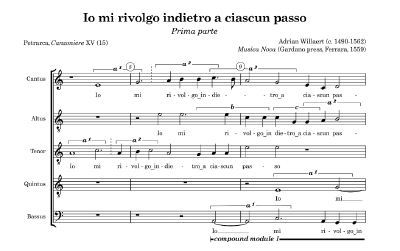
|
Prima parte Seconda parte |
Typeset by Allen Garvin (aurvondel@gmail.com) (ver. 2016-08-28) CC BY-NC 2.5
https://www.cpdl.org/wiki/index.php/Io_mi_rivolgo_indietro_a_ciascun_passo_(Adrian_Willaert).
Garvin’s edition maintains original note values. It is based on: Willaert, Adriani. 1966. Opera Omnia, v. 13: Musica Nova 1559 Madrigalia (CMM 3), 49–54. Edited by Hermann Zenck and Walter Gerstenberg. AIM. Text and ficta are based on the CMM edition, but measures have been renumbered here in minims.
Appendix 2: Schematic Analysis
 |
Appendix 3: Text and Translation
| Io mi rivolgo indietro a ciascun passo | I turn back at every step I take |
| col corpo stancho ch'a gran pena porto, | with weary body that has borne great pain, |
| et prendo allor del vostr'aere conforto | and take comfort then from your aspect |
| che 'l fa gir oltra dicendo: Oimè lasso! | that make me go on, saying: Ah me! |
| Poi ripensando al dolce ben ch'io lasso, | Then thinking of the sweet good I leave, |
| al camin lungo et al mio viver corto, | of the long road, and of my brief life, |
| fermo le piante sbigottito et smorto, | I halt my steps, dismayed and pale, |
| et gli occhi in terra lagrimando abasso. | and lower my eyes weeping to the ground. |
| Talor m'assale in mezzo a'tristi pianti | Sometimes a doubt assails me in the midst |
| un dubbio: come posson queste membra | of sad tears: how can these limbs |
| da lo spirito lor viver lontane? | live separated from their spirit? |
| Ma rispondemi Amor: Non ti rimembra | But Love replies: Do you not remember |
| che questo è privilegio degli amanti, | that this is the privilege of lovers, |
| sciolti da tutte qualitati humane? | freed from every other human tie? |
Trans. A. S. Kline (http://petrarch.petersadlon.com/canzoniere.html?poem=15)
Copyright Statement
Copyright © 2022 by the Society for Music Theory. All rights reserved.
[1] Copyrights for individual items published in Music Theory Online (MTO) are held by their authors. Items appearing in MTO may be saved and stored in electronic or paper form, and may be shared among individuals for purposes of scholarly research or discussion, but may not be republished in any form, electronic or print, without prior, written permission from the author(s), and advance notification of the editors of MTO.
[2] Any redistributed form of items published in MTO must include the following information in a form appropriate to the medium in which the items are to appear:
This item appeared in Music Theory Online in [VOLUME #, ISSUE #] on [DAY/MONTH/YEAR]. It was authored by [FULL NAME, EMAIL ADDRESS], with whose written permission it is reprinted here.
[3] Libraries may archive issues of MTO in electronic or paper form for public access so long as each issue is stored in its entirety, and no access fee is charged. Exceptions to these requirements must be approved in writing by the editors of MTO, who will act in accordance with the decisions of the Society for Music Theory.
This document and all portions thereof are protected by U.S. and international copyright laws. Material contained herein may be copied and/or distributed for research purposes only.
Prepared by Fred Hosken, Editorial Assistant
Number of visits:
5992

